Human Resource Management Report: Workforce Planning at Tesco Plc
VerifiedAdded on 2023/01/06
|16
|4485
|50
Report
AI Summary
This report provides a detailed analysis of human resource management (HRM) practices at Tesco Plc. It begins by defining HRM and discussing its purpose and functions, specifically in the context of workforce planning and resourcing within the organization. The report then examines different approaches to recruitment and selection, outlining their strengths and weaknesses. It further explores the benefits of various HRM practices, such as training and development, performance management, and reward systems, for both the employer and employees. The effectiveness of these practices in raising organizational profit and productivity is also evaluated. The report also covers the key elements of employment legislation and its impact on HRM decision-making, and demonstrates the application of HRM practices with work-related examples. The report provides a comprehensive overview of HRM strategies and their practical implications within a major multinational corporation like Tesco.
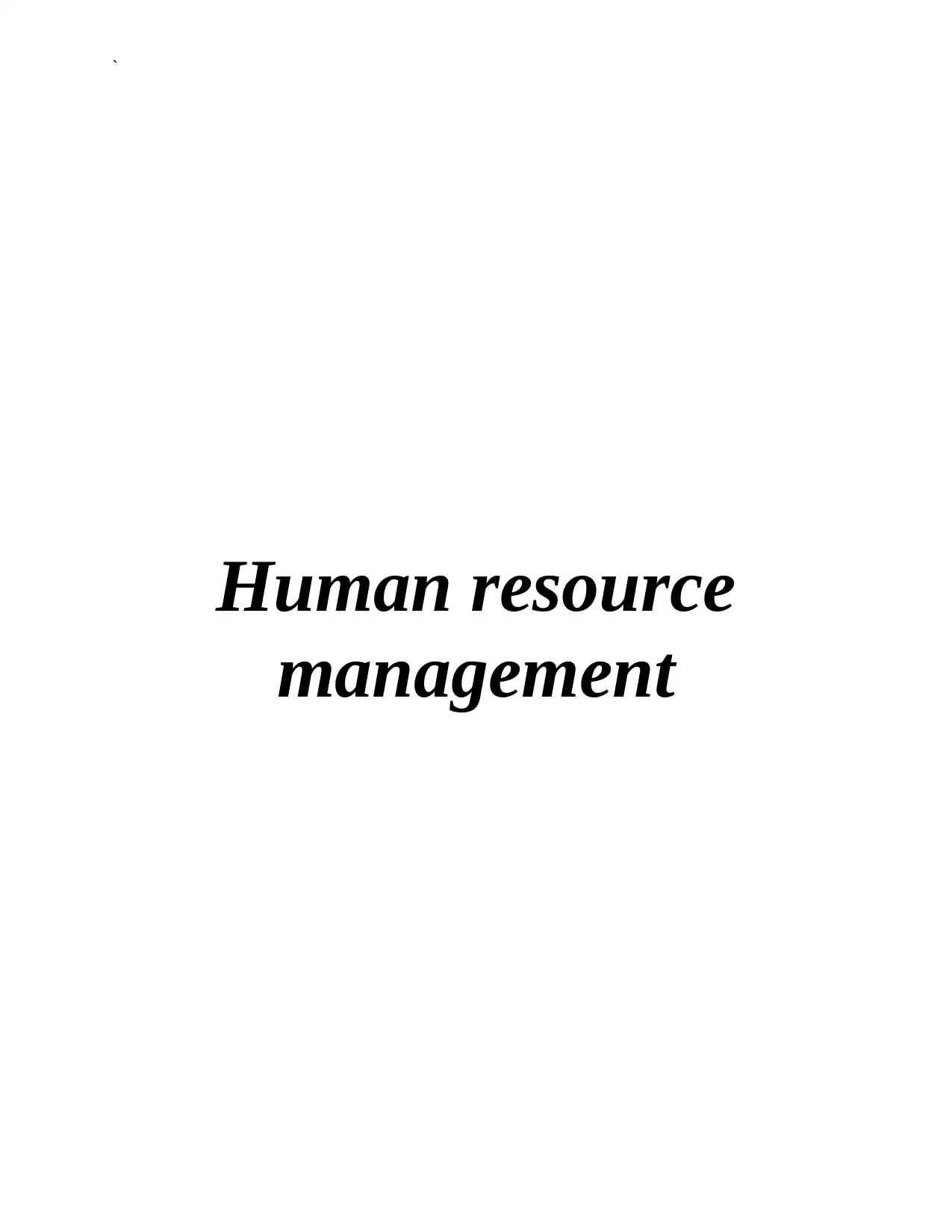
`
Human resource
management
Human resource
management
Paraphrase This Document
Need a fresh take? Get an instant paraphrase of this document with our AI Paraphraser
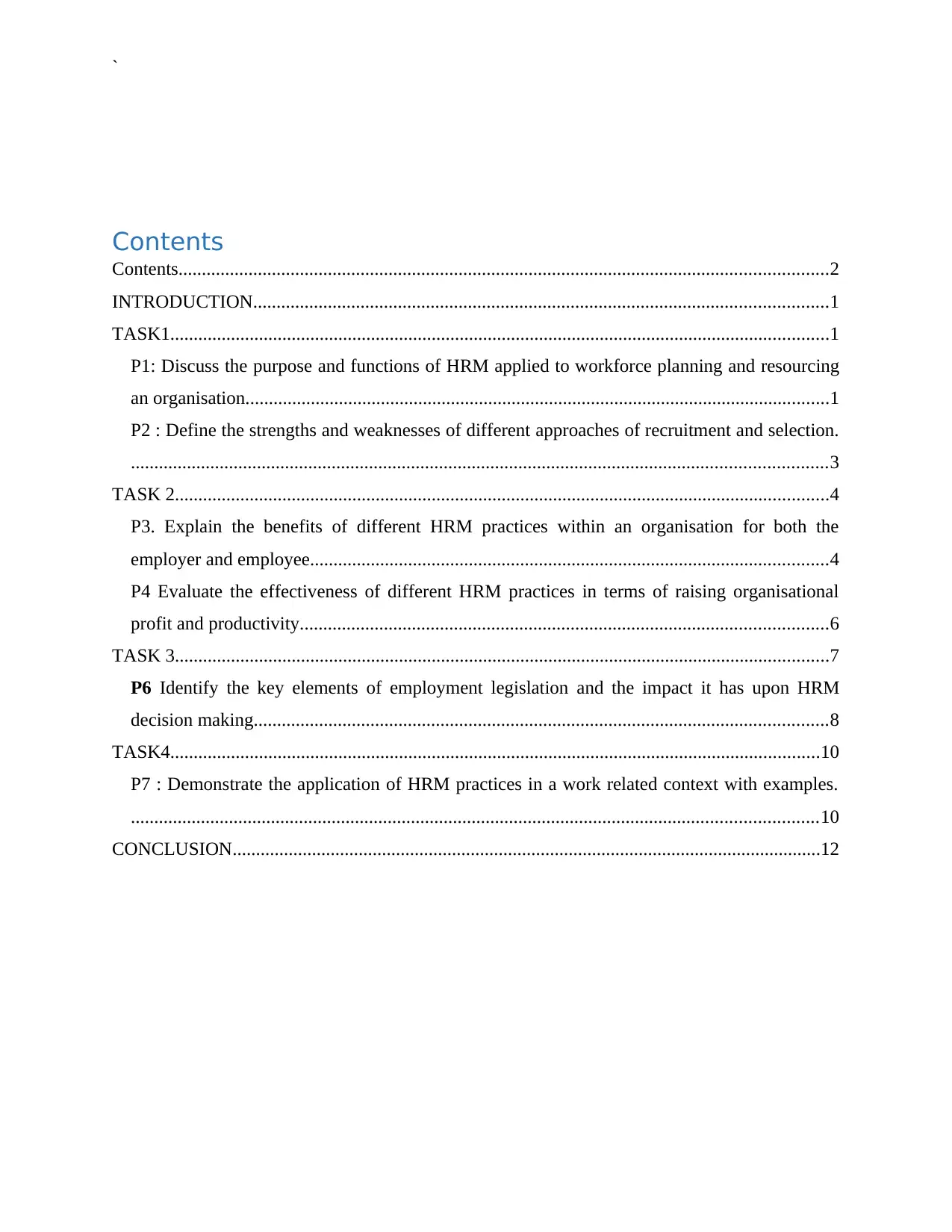
`
Contents
Contents...........................................................................................................................................2
INTRODUCTION...........................................................................................................................1
TASK1.............................................................................................................................................1
P1: Discuss the purpose and functions of HRM applied to workforce planning and resourcing
an organisation.............................................................................................................................1
P2 : Define the strengths and weaknesses of different approaches of recruitment and selection.
.....................................................................................................................................................3
TASK 2............................................................................................................................................4
P3. Explain the benefits of different HRM practices within an organisation for both the
employer and employee...............................................................................................................4
P4 Evaluate the effectiveness of different HRM practices in terms of raising organisational
profit and productivity.................................................................................................................6
TASK 3............................................................................................................................................7
P6 Identify the key elements of employment legislation and the impact it has upon HRM
decision making...........................................................................................................................8
TASK4...........................................................................................................................................10
P7 : Demonstrate the application of HRM practices in a work related context with examples.
...................................................................................................................................................10
CONCLUSION..............................................................................................................................12
Contents
Contents...........................................................................................................................................2
INTRODUCTION...........................................................................................................................1
TASK1.............................................................................................................................................1
P1: Discuss the purpose and functions of HRM applied to workforce planning and resourcing
an organisation.............................................................................................................................1
P2 : Define the strengths and weaknesses of different approaches of recruitment and selection.
.....................................................................................................................................................3
TASK 2............................................................................................................................................4
P3. Explain the benefits of different HRM practices within an organisation for both the
employer and employee...............................................................................................................4
P4 Evaluate the effectiveness of different HRM practices in terms of raising organisational
profit and productivity.................................................................................................................6
TASK 3............................................................................................................................................7
P6 Identify the key elements of employment legislation and the impact it has upon HRM
decision making...........................................................................................................................8
TASK4...........................................................................................................................................10
P7 : Demonstrate the application of HRM practices in a work related context with examples.
...................................................................................................................................................10
CONCLUSION..............................................................................................................................12

`
⊘ This is a preview!⊘
Do you want full access?
Subscribe today to unlock all pages.

Trusted by 1+ million students worldwide
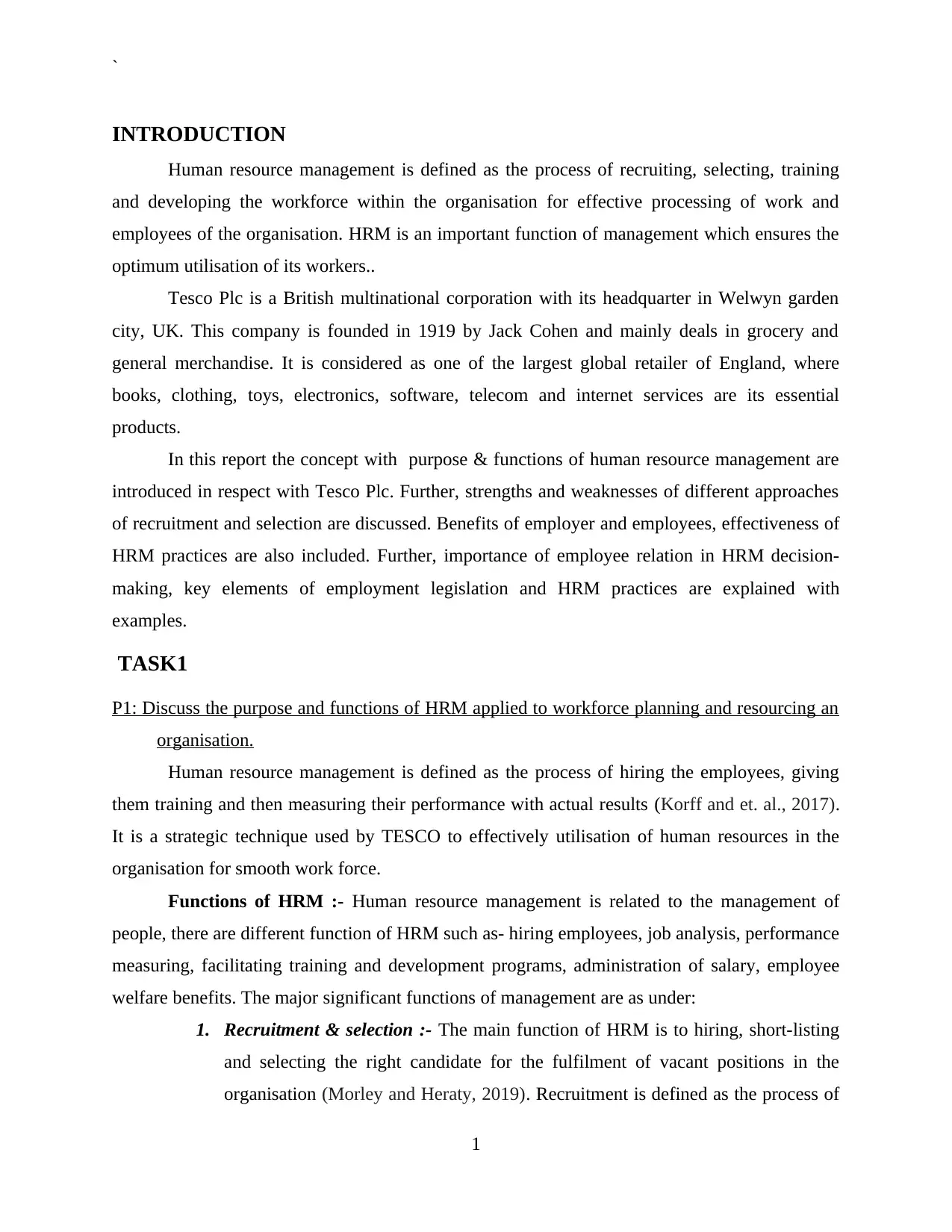
`
INTRODUCTION
Human resource management is defined as the process of recruiting, selecting, training
and developing the workforce within the organisation for effective processing of work and
employees of the organisation. HRM is an important function of management which ensures the
optimum utilisation of its workers..
Tesco Plc is a British multinational corporation with its headquarter in Welwyn garden
city, UK. This company is founded in 1919 by Jack Cohen and mainly deals in grocery and
general merchandise. It is considered as one of the largest global retailer of England, where
books, clothing, toys, electronics, software, telecom and internet services are its essential
products.
In this report the concept with purpose & functions of human resource management are
introduced in respect with Tesco Plc. Further, strengths and weaknesses of different approaches
of recruitment and selection are discussed. Benefits of employer and employees, effectiveness of
HRM practices are also included. Further, importance of employee relation in HRM decision-
making, key elements of employment legislation and HRM practices are explained with
examples.
TASK1
P1: Discuss the purpose and functions of HRM applied to workforce planning and resourcing an
organisation.
Human resource management is defined as the process of hiring the employees, giving
them training and then measuring their performance with actual results (Korff and et. al., 2017).
It is a strategic technique used by TESCO to effectively utilisation of human resources in the
organisation for smooth work force.
Functions of HRM :- Human resource management is related to the management of
people, there are different function of HRM such as- hiring employees, job analysis, performance
measuring, facilitating training and development programs, administration of salary, employee
welfare benefits. The major significant functions of management are as under:
1. Recruitment & selection :- The main function of HRM is to hiring, short-listing
and selecting the right candidate for the fulfilment of vacant positions in the
organisation (Morley and Heraty, 2019). Recruitment is defined as the process of
1
INTRODUCTION
Human resource management is defined as the process of recruiting, selecting, training
and developing the workforce within the organisation for effective processing of work and
employees of the organisation. HRM is an important function of management which ensures the
optimum utilisation of its workers..
Tesco Plc is a British multinational corporation with its headquarter in Welwyn garden
city, UK. This company is founded in 1919 by Jack Cohen and mainly deals in grocery and
general merchandise. It is considered as one of the largest global retailer of England, where
books, clothing, toys, electronics, software, telecom and internet services are its essential
products.
In this report the concept with purpose & functions of human resource management are
introduced in respect with Tesco Plc. Further, strengths and weaknesses of different approaches
of recruitment and selection are discussed. Benefits of employer and employees, effectiveness of
HRM practices are also included. Further, importance of employee relation in HRM decision-
making, key elements of employment legislation and HRM practices are explained with
examples.
TASK1
P1: Discuss the purpose and functions of HRM applied to workforce planning and resourcing an
organisation.
Human resource management is defined as the process of hiring the employees, giving
them training and then measuring their performance with actual results (Korff and et. al., 2017).
It is a strategic technique used by TESCO to effectively utilisation of human resources in the
organisation for smooth work force.
Functions of HRM :- Human resource management is related to the management of
people, there are different function of HRM such as- hiring employees, job analysis, performance
measuring, facilitating training and development programs, administration of salary, employee
welfare benefits. The major significant functions of management are as under:
1. Recruitment & selection :- The main function of HRM is to hiring, short-listing
and selecting the right candidate for the fulfilment of vacant positions in the
organisation (Morley and Heraty, 2019). Recruitment is defined as the process of
1
Paraphrase This Document
Need a fresh take? Get an instant paraphrase of this document with our AI Paraphraser
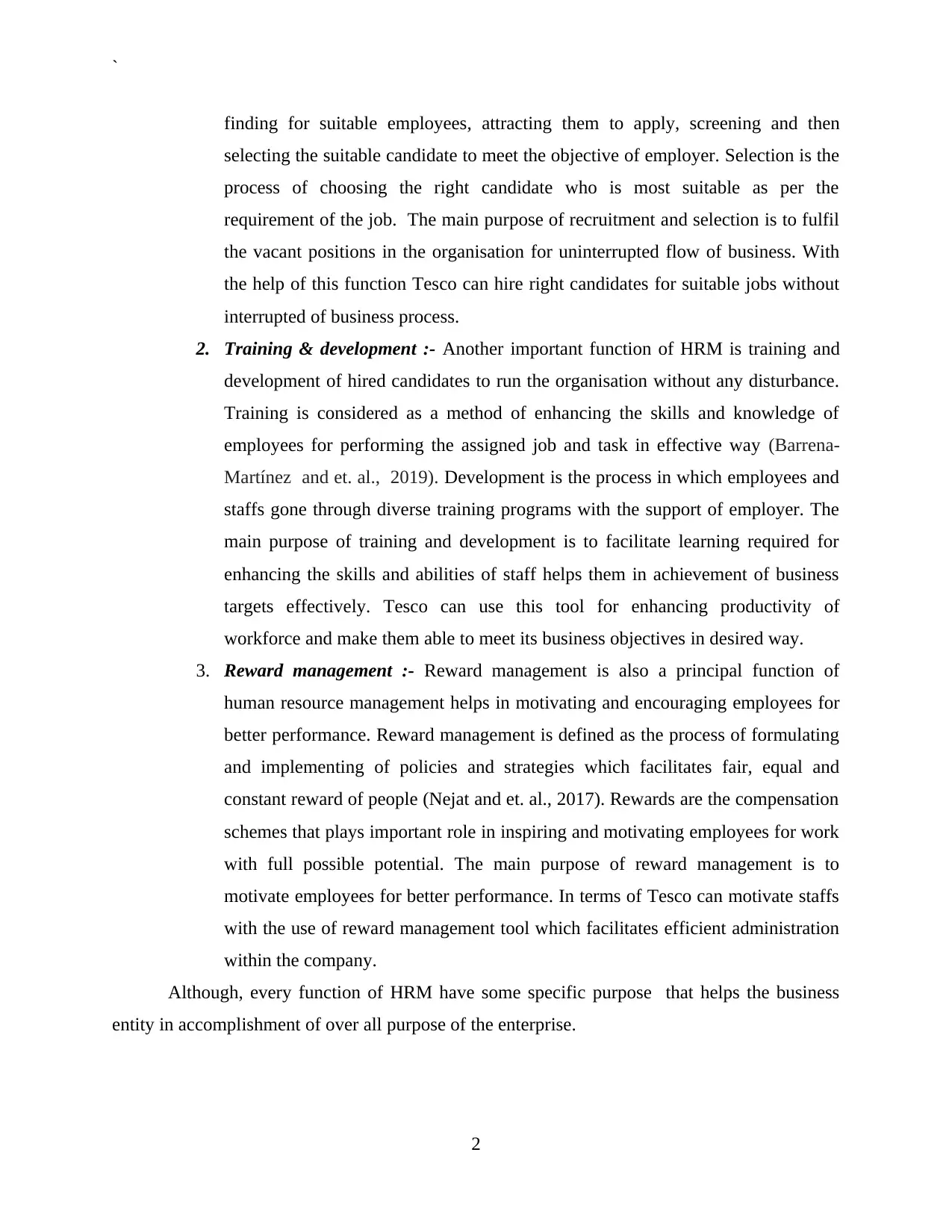
`
finding for suitable employees, attracting them to apply, screening and then
selecting the suitable candidate to meet the objective of employer. Selection is the
process of choosing the right candidate who is most suitable as per the
requirement of the job. The main purpose of recruitment and selection is to fulfil
the vacant positions in the organisation for uninterrupted flow of business. With
the help of this function Tesco can hire right candidates for suitable jobs without
interrupted of business process.
2. Training & development :- Another important function of HRM is training and
development of hired candidates to run the organisation without any disturbance.
Training is considered as a method of enhancing the skills and knowledge of
employees for performing the assigned job and task in effective way (Barrena-
Martínez and et. al., 2019). Development is the process in which employees and
staffs gone through diverse training programs with the support of employer. The
main purpose of training and development is to facilitate learning required for
enhancing the skills and abilities of staff helps them in achievement of business
targets effectively. Tesco can use this tool for enhancing productivity of
workforce and make them able to meet its business objectives in desired way.
3. Reward management :- Reward management is also a principal function of
human resource management helps in motivating and encouraging employees for
better performance. Reward management is defined as the process of formulating
and implementing of policies and strategies which facilitates fair, equal and
constant reward of people (Nejat and et. al., 2017). Rewards are the compensation
schemes that plays important role in inspiring and motivating employees for work
with full possible potential. The main purpose of reward management is to
motivate employees for better performance. In terms of Tesco can motivate staffs
with the use of reward management tool which facilitates efficient administration
within the company.
Although, every function of HRM have some specific purpose that helps the business
entity in accomplishment of over all purpose of the enterprise.
2
finding for suitable employees, attracting them to apply, screening and then
selecting the suitable candidate to meet the objective of employer. Selection is the
process of choosing the right candidate who is most suitable as per the
requirement of the job. The main purpose of recruitment and selection is to fulfil
the vacant positions in the organisation for uninterrupted flow of business. With
the help of this function Tesco can hire right candidates for suitable jobs without
interrupted of business process.
2. Training & development :- Another important function of HRM is training and
development of hired candidates to run the organisation without any disturbance.
Training is considered as a method of enhancing the skills and knowledge of
employees for performing the assigned job and task in effective way (Barrena-
Martínez and et. al., 2019). Development is the process in which employees and
staffs gone through diverse training programs with the support of employer. The
main purpose of training and development is to facilitate learning required for
enhancing the skills and abilities of staff helps them in achievement of business
targets effectively. Tesco can use this tool for enhancing productivity of
workforce and make them able to meet its business objectives in desired way.
3. Reward management :- Reward management is also a principal function of
human resource management helps in motivating and encouraging employees for
better performance. Reward management is defined as the process of formulating
and implementing of policies and strategies which facilitates fair, equal and
constant reward of people (Nejat and et. al., 2017). Rewards are the compensation
schemes that plays important role in inspiring and motivating employees for work
with full possible potential. The main purpose of reward management is to
motivate employees for better performance. In terms of Tesco can motivate staffs
with the use of reward management tool which facilitates efficient administration
within the company.
Although, every function of HRM have some specific purpose that helps the business
entity in accomplishment of over all purpose of the enterprise.
2
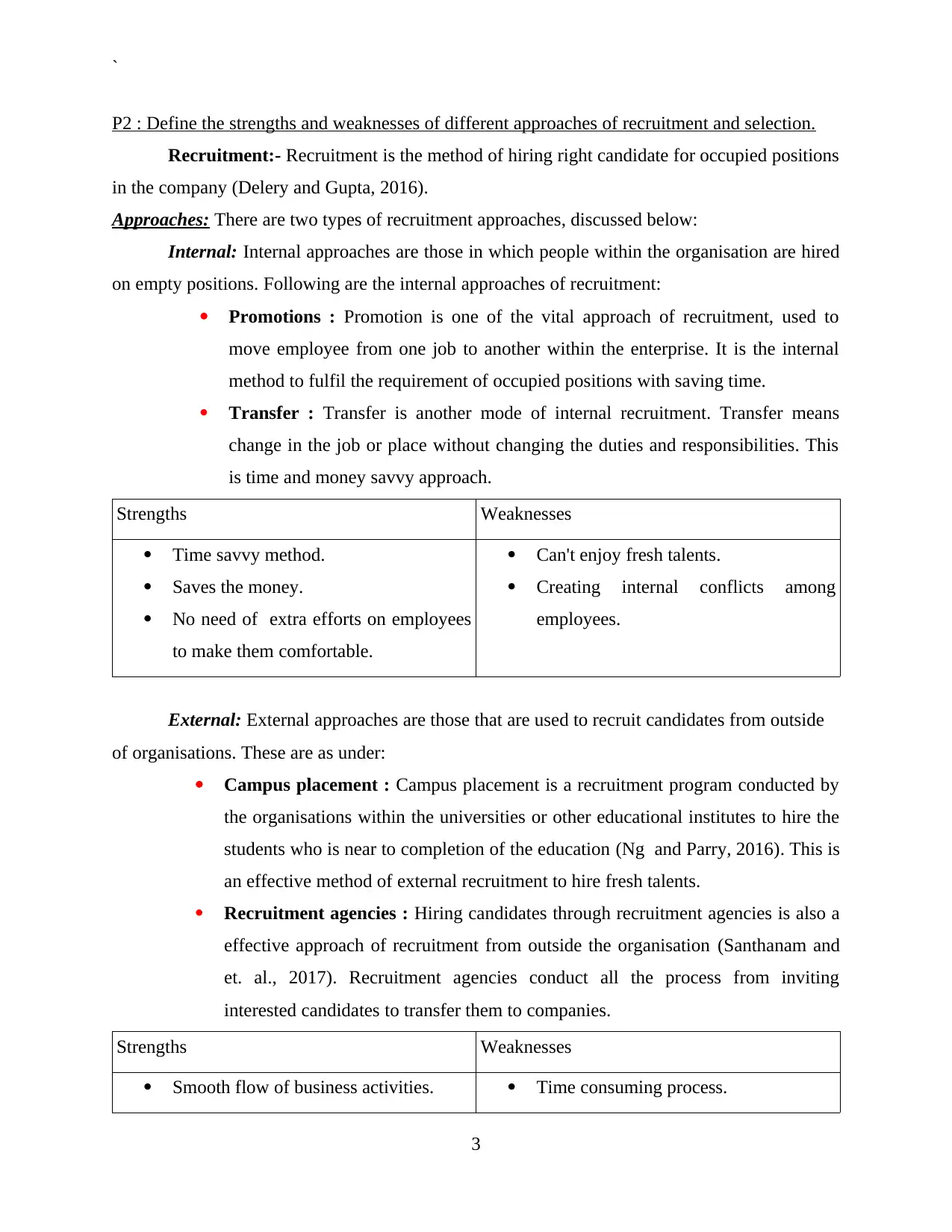
`
P2 : Define the strengths and weaknesses of different approaches of recruitment and selection.
Recruitment:- Recruitment is the method of hiring right candidate for occupied positions
in the company (Delery and Gupta, 2016).
Approaches: There are two types of recruitment approaches, discussed below:
Internal: Internal approaches are those in which people within the organisation are hired
on empty positions. Following are the internal approaches of recruitment:
Promotions : Promotion is one of the vital approach of recruitment, used to
move employee from one job to another within the enterprise. It is the internal
method to fulfil the requirement of occupied positions with saving time.
Transfer : Transfer is another mode of internal recruitment. Transfer means
change in the job or place without changing the duties and responsibilities. This
is time and money savvy approach.
Strengths Weaknesses
Time savvy method.
Saves the money.
No need of extra efforts on employees
to make them comfortable.
Can't enjoy fresh talents.
Creating internal conflicts among
employees.
External: External approaches are those that are used to recruit candidates from outside
of organisations. These are as under:
Campus placement : Campus placement is a recruitment program conducted by
the organisations within the universities or other educational institutes to hire the
students who is near to completion of the education (Ng and Parry, 2016). This is
an effective method of external recruitment to hire fresh talents.
Recruitment agencies : Hiring candidates through recruitment agencies is also a
effective approach of recruitment from outside the organisation (Santhanam and
et. al., 2017). Recruitment agencies conduct all the process from inviting
interested candidates to transfer them to companies.
Strengths Weaknesses
Smooth flow of business activities. Time consuming process.
3
P2 : Define the strengths and weaknesses of different approaches of recruitment and selection.
Recruitment:- Recruitment is the method of hiring right candidate for occupied positions
in the company (Delery and Gupta, 2016).
Approaches: There are two types of recruitment approaches, discussed below:
Internal: Internal approaches are those in which people within the organisation are hired
on empty positions. Following are the internal approaches of recruitment:
Promotions : Promotion is one of the vital approach of recruitment, used to
move employee from one job to another within the enterprise. It is the internal
method to fulfil the requirement of occupied positions with saving time.
Transfer : Transfer is another mode of internal recruitment. Transfer means
change in the job or place without changing the duties and responsibilities. This
is time and money savvy approach.
Strengths Weaknesses
Time savvy method.
Saves the money.
No need of extra efforts on employees
to make them comfortable.
Can't enjoy fresh talents.
Creating internal conflicts among
employees.
External: External approaches are those that are used to recruit candidates from outside
of organisations. These are as under:
Campus placement : Campus placement is a recruitment program conducted by
the organisations within the universities or other educational institutes to hire the
students who is near to completion of the education (Ng and Parry, 2016). This is
an effective method of external recruitment to hire fresh talents.
Recruitment agencies : Hiring candidates through recruitment agencies is also a
effective approach of recruitment from outside the organisation (Santhanam and
et. al., 2017). Recruitment agencies conduct all the process from inviting
interested candidates to transfer them to companies.
Strengths Weaknesses
Smooth flow of business activities. Time consuming process.
3
⊘ This is a preview!⊘
Do you want full access?
Subscribe today to unlock all pages.

Trusted by 1+ million students worldwide
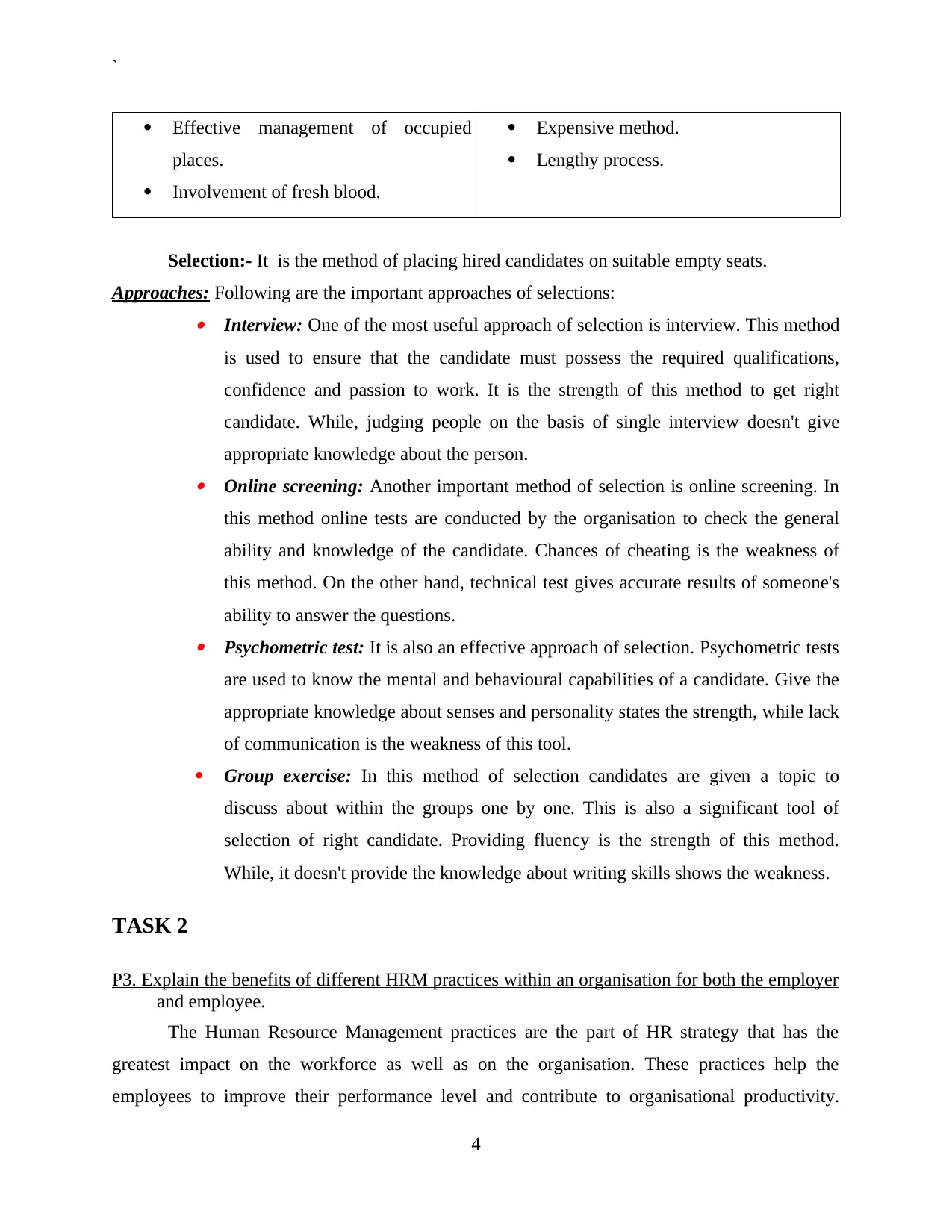
`
Effective management of occupied
places.
Involvement of fresh blood.
Expensive method.
Lengthy process.
Selection:- It is the method of placing hired candidates on suitable empty seats.
Approaches: Following are the important approaches of selections:
Interview: One of the most useful approach of selection is interview. This method
is used to ensure that the candidate must possess the required qualifications,
confidence and passion to work. It is the strength of this method to get right
candidate. While, judging people on the basis of single interview doesn't give
appropriate knowledge about the person.
Online screening: Another important method of selection is online screening. In
this method online tests are conducted by the organisation to check the general
ability and knowledge of the candidate. Chances of cheating is the weakness of
this method. On the other hand, technical test gives accurate results of someone's
ability to answer the questions.
Psychometric test: It is also an effective approach of selection. Psychometric tests
are used to know the mental and behavioural capabilities of a candidate. Give the
appropriate knowledge about senses and personality states the strength, while lack
of communication is the weakness of this tool.
Group exercise: In this method of selection candidates are given a topic to
discuss about within the groups one by one. This is also a significant tool of
selection of right candidate. Providing fluency is the strength of this method.
While, it doesn't provide the knowledge about writing skills shows the weakness.
TASK 2
P3. Explain the benefits of different HRM practices within an organisation for both the employer
and employee.
The Human Resource Management practices are the part of HR strategy that has the
greatest impact on the workforce as well as on the organisation. These practices help the
employees to improve their performance level and contribute to organisational productivity.
4
Effective management of occupied
places.
Involvement of fresh blood.
Expensive method.
Lengthy process.
Selection:- It is the method of placing hired candidates on suitable empty seats.
Approaches: Following are the important approaches of selections:
Interview: One of the most useful approach of selection is interview. This method
is used to ensure that the candidate must possess the required qualifications,
confidence and passion to work. It is the strength of this method to get right
candidate. While, judging people on the basis of single interview doesn't give
appropriate knowledge about the person.
Online screening: Another important method of selection is online screening. In
this method online tests are conducted by the organisation to check the general
ability and knowledge of the candidate. Chances of cheating is the weakness of
this method. On the other hand, technical test gives accurate results of someone's
ability to answer the questions.
Psychometric test: It is also an effective approach of selection. Psychometric tests
are used to know the mental and behavioural capabilities of a candidate. Give the
appropriate knowledge about senses and personality states the strength, while lack
of communication is the weakness of this tool.
Group exercise: In this method of selection candidates are given a topic to
discuss about within the groups one by one. This is also a significant tool of
selection of right candidate. Providing fluency is the strength of this method.
While, it doesn't provide the knowledge about writing skills shows the weakness.
TASK 2
P3. Explain the benefits of different HRM practices within an organisation for both the employer
and employee.
The Human Resource Management practices are the part of HR strategy that has the
greatest impact on the workforce as well as on the organisation. These practices help the
employees to improve their performance level and contribute to organisational productivity.
4
Paraphrase This Document
Need a fresh take? Get an instant paraphrase of this document with our AI Paraphraser
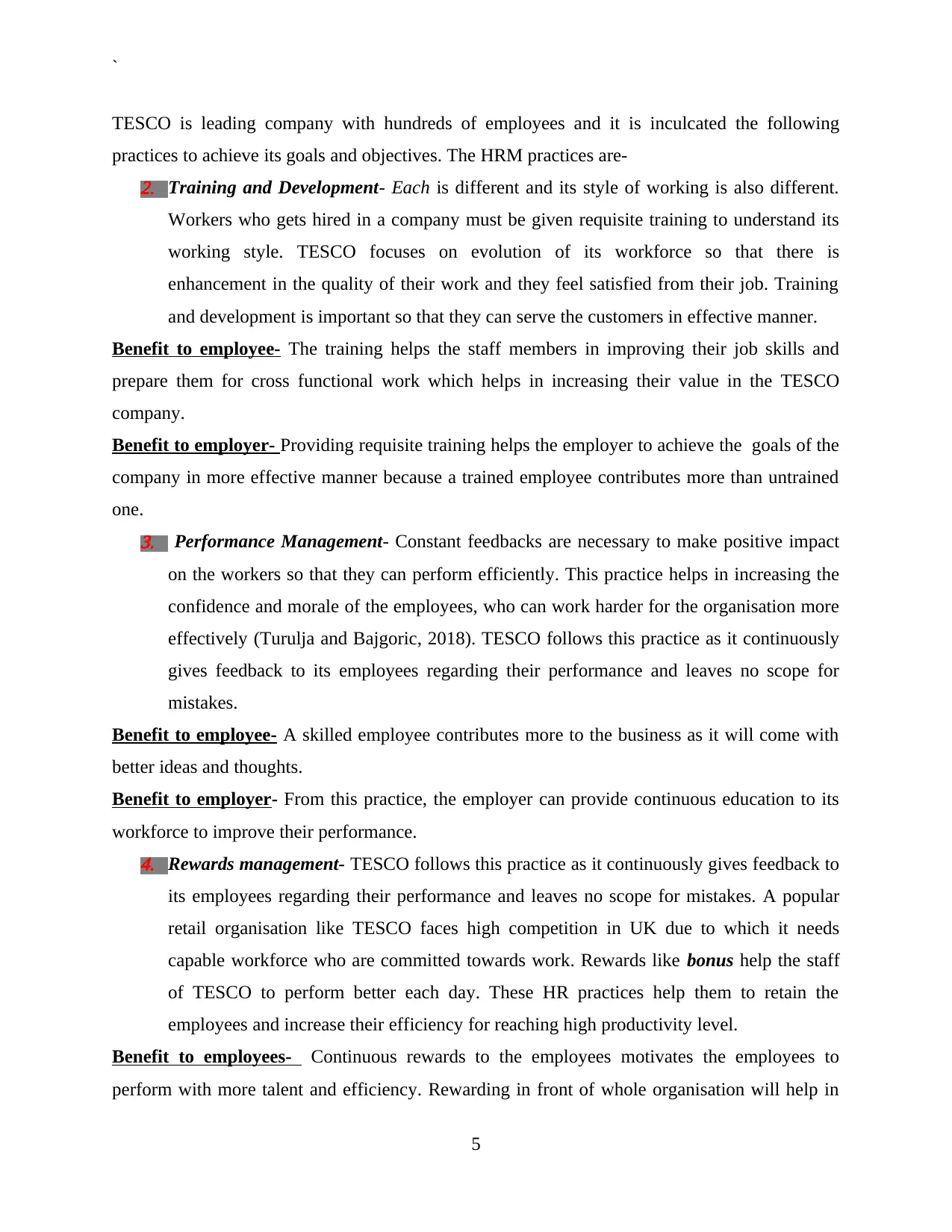
`
TESCO is leading company with hundreds of employees and it is inculcated the following
practices to achieve its goals and objectives. The HRM practices are-2. Training and Development- Each is different and its style of working is also different.
Workers who gets hired in a company must be given requisite training to understand its
working style. TESCO focuses on evolution of its workforce so that there is
enhancement in the quality of their work and they feel satisfied from their job. Training
and development is important so that they can serve the customers in effective manner.
Benefit to employee- The training helps the staff members in improving their job skills and
prepare them for cross functional work which helps in increasing their value in the TESCO
company.
Benefit to employer- Providing requisite training helps the employer to achieve the goals of the
company in more effective manner because a trained employee contributes more than untrained
one.3. Performance Management- Constant feedbacks are necessary to make positive impact
on the workers so that they can perform efficiently. This practice helps in increasing the
confidence and morale of the employees, who can work harder for the organisation more
effectively (Turulja and Bajgoric, 2018). TESCO follows this practice as it continuously
gives feedback to its employees regarding their performance and leaves no scope for
mistakes.
Benefit to employee- A skilled employee contributes more to the business as it will come with
better ideas and thoughts.
Benefit to employer- From this practice, the employer can provide continuous education to its
workforce to improve their performance.4. Rewards management- TESCO follows this practice as it continuously gives feedback to
its employees regarding their performance and leaves no scope for mistakes. A popular
retail organisation like TESCO faces high competition in UK due to which it needs
capable workforce who are committed towards work. Rewards like bonus help the staff
of TESCO to perform better each day. These HR practices help them to retain the
employees and increase their efficiency for reaching high productivity level.
Benefit to employees- Continuous rewards to the employees motivates the employees to
perform with more talent and efficiency. Rewarding in front of whole organisation will help in
5
TESCO is leading company with hundreds of employees and it is inculcated the following
practices to achieve its goals and objectives. The HRM practices are-2. Training and Development- Each is different and its style of working is also different.
Workers who gets hired in a company must be given requisite training to understand its
working style. TESCO focuses on evolution of its workforce so that there is
enhancement in the quality of their work and they feel satisfied from their job. Training
and development is important so that they can serve the customers in effective manner.
Benefit to employee- The training helps the staff members in improving their job skills and
prepare them for cross functional work which helps in increasing their value in the TESCO
company.
Benefit to employer- Providing requisite training helps the employer to achieve the goals of the
company in more effective manner because a trained employee contributes more than untrained
one.3. Performance Management- Constant feedbacks are necessary to make positive impact
on the workers so that they can perform efficiently. This practice helps in increasing the
confidence and morale of the employees, who can work harder for the organisation more
effectively (Turulja and Bajgoric, 2018). TESCO follows this practice as it continuously
gives feedback to its employees regarding their performance and leaves no scope for
mistakes.
Benefit to employee- A skilled employee contributes more to the business as it will come with
better ideas and thoughts.
Benefit to employer- From this practice, the employer can provide continuous education to its
workforce to improve their performance.4. Rewards management- TESCO follows this practice as it continuously gives feedback to
its employees regarding their performance and leaves no scope for mistakes. A popular
retail organisation like TESCO faces high competition in UK due to which it needs
capable workforce who are committed towards work. Rewards like bonus help the staff
of TESCO to perform better each day. These HR practices help them to retain the
employees and increase their efficiency for reaching high productivity level.
Benefit to employees- Continuous rewards to the employees motivates the employees to
perform with more talent and efficiency. Rewarding in front of whole organisation will help in
5
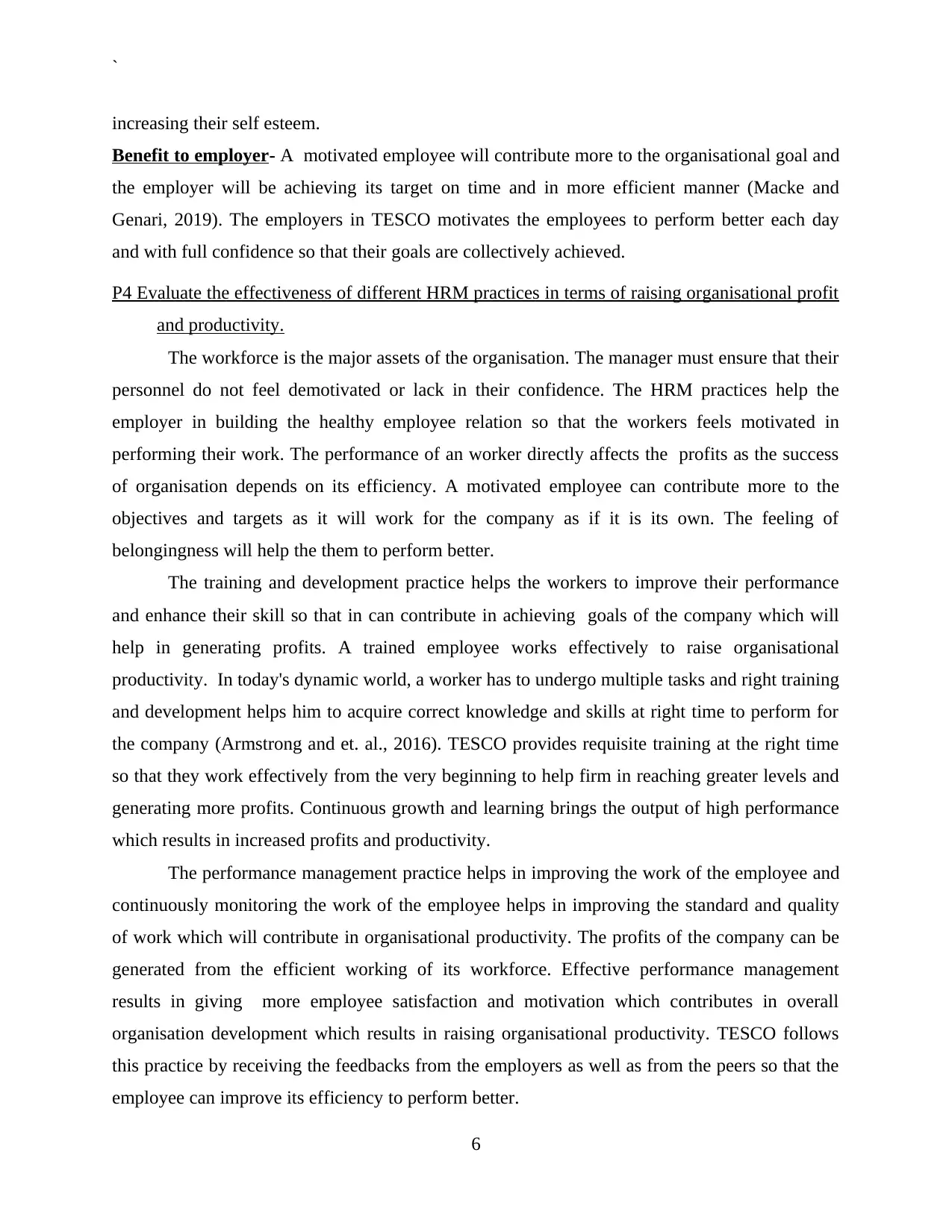
`
increasing their self esteem.
Benefit to employer- A motivated employee will contribute more to the organisational goal and
the employer will be achieving its target on time and in more efficient manner (Macke and
Genari, 2019). The employers in TESCO motivates the employees to perform better each day
and with full confidence so that their goals are collectively achieved.
P4 Evaluate the effectiveness of different HRM practices in terms of raising organisational profit
and productivity.
The workforce is the major assets of the organisation. The manager must ensure that their
personnel do not feel demotivated or lack in their confidence. The HRM practices help the
employer in building the healthy employee relation so that the workers feels motivated in
performing their work. The performance of an worker directly affects the profits as the success
of organisation depends on its efficiency. A motivated employee can contribute more to the
objectives and targets as it will work for the company as if it is its own. The feeling of
belongingness will help the them to perform better.
The training and development practice helps the workers to improve their performance
and enhance their skill so that in can contribute in achieving goals of the company which will
help in generating profits. A trained employee works effectively to raise organisational
productivity. In today's dynamic world, a worker has to undergo multiple tasks and right training
and development helps him to acquire correct knowledge and skills at right time to perform for
the company (Armstrong and et. al., 2016). TESCO provides requisite training at the right time
so that they work effectively from the very beginning to help firm in reaching greater levels and
generating more profits. Continuous growth and learning brings the output of high performance
which results in increased profits and productivity.
The performance management practice helps in improving the work of the employee and
continuously monitoring the work of the employee helps in improving the standard and quality
of work which will contribute in organisational productivity. The profits of the company can be
generated from the efficient working of its workforce. Effective performance management
results in giving more employee satisfaction and motivation which contributes in overall
organisation development which results in raising organisational productivity. TESCO follows
this practice by receiving the feedbacks from the employers as well as from the peers so that the
employee can improve its efficiency to perform better.
6
increasing their self esteem.
Benefit to employer- A motivated employee will contribute more to the organisational goal and
the employer will be achieving its target on time and in more efficient manner (Macke and
Genari, 2019). The employers in TESCO motivates the employees to perform better each day
and with full confidence so that their goals are collectively achieved.
P4 Evaluate the effectiveness of different HRM practices in terms of raising organisational profit
and productivity.
The workforce is the major assets of the organisation. The manager must ensure that their
personnel do not feel demotivated or lack in their confidence. The HRM practices help the
employer in building the healthy employee relation so that the workers feels motivated in
performing their work. The performance of an worker directly affects the profits as the success
of organisation depends on its efficiency. A motivated employee can contribute more to the
objectives and targets as it will work for the company as if it is its own. The feeling of
belongingness will help the them to perform better.
The training and development practice helps the workers to improve their performance
and enhance their skill so that in can contribute in achieving goals of the company which will
help in generating profits. A trained employee works effectively to raise organisational
productivity. In today's dynamic world, a worker has to undergo multiple tasks and right training
and development helps him to acquire correct knowledge and skills at right time to perform for
the company (Armstrong and et. al., 2016). TESCO provides requisite training at the right time
so that they work effectively from the very beginning to help firm in reaching greater levels and
generating more profits. Continuous growth and learning brings the output of high performance
which results in increased profits and productivity.
The performance management practice helps in improving the work of the employee and
continuously monitoring the work of the employee helps in improving the standard and quality
of work which will contribute in organisational productivity. The profits of the company can be
generated from the efficient working of its workforce. Effective performance management
results in giving more employee satisfaction and motivation which contributes in overall
organisation development which results in raising organisational productivity. TESCO follows
this practice by receiving the feedbacks from the employers as well as from the peers so that the
employee can improve its efficiency to perform better.
6
⊘ This is a preview!⊘
Do you want full access?
Subscribe today to unlock all pages.

Trusted by 1+ million students worldwide
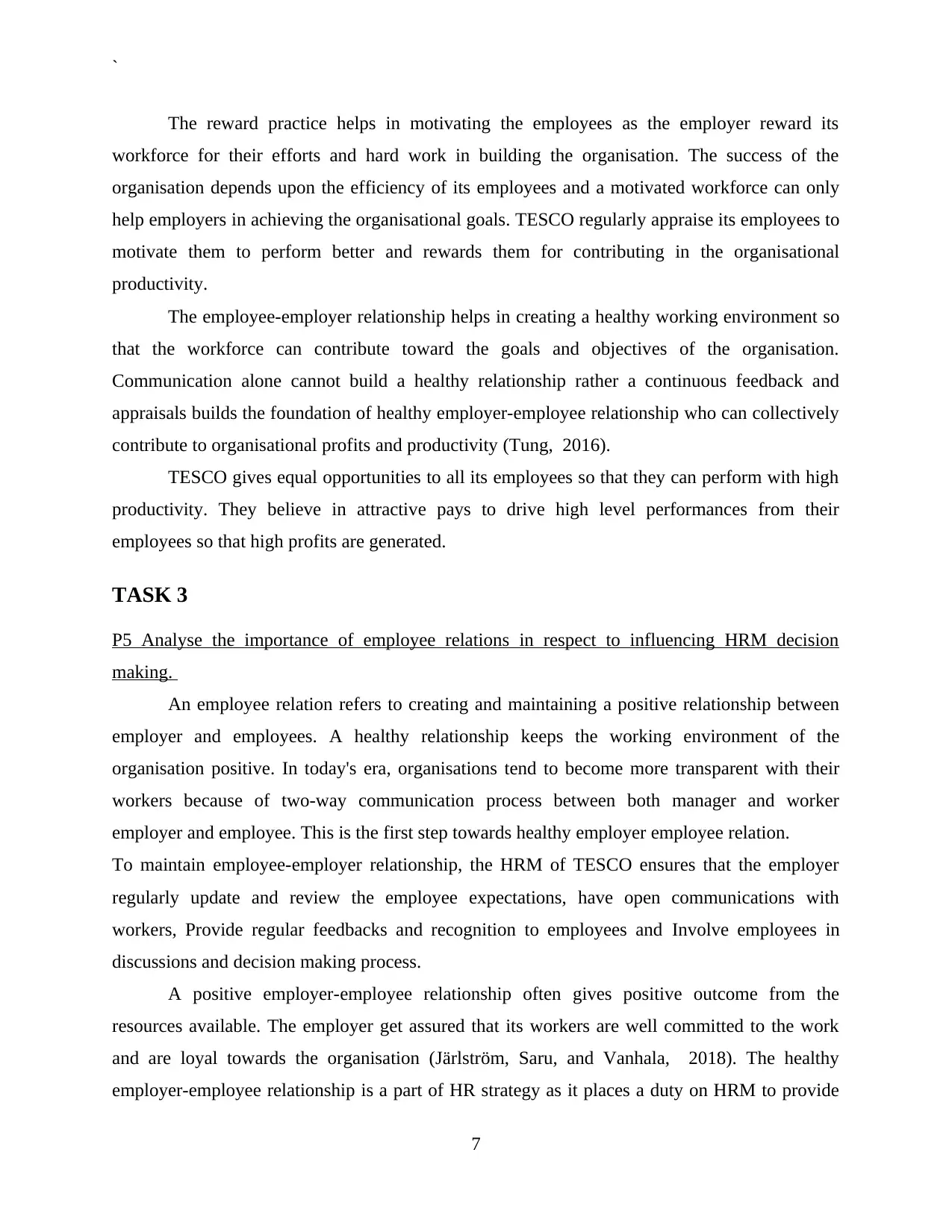
`
The reward practice helps in motivating the employees as the employer reward its
workforce for their efforts and hard work in building the organisation. The success of the
organisation depends upon the efficiency of its employees and a motivated workforce can only
help employers in achieving the organisational goals. TESCO regularly appraise its employees to
motivate them to perform better and rewards them for contributing in the organisational
productivity.
The employee-employer relationship helps in creating a healthy working environment so
that the workforce can contribute toward the goals and objectives of the organisation.
Communication alone cannot build a healthy relationship rather a continuous feedback and
appraisals builds the foundation of healthy employer-employee relationship who can collectively
contribute to organisational profits and productivity (Tung, 2016).
TESCO gives equal opportunities to all its employees so that they can perform with high
productivity. They believe in attractive pays to drive high level performances from their
employees so that high profits are generated.
TASK 3
P5 Analyse the importance of employee relations in respect to influencing HRM decision
making.
An employee relation refers to creating and maintaining a positive relationship between
employer and employees. A healthy relationship keeps the working environment of the
organisation positive. In today's era, organisations tend to become more transparent with their
workers because of two-way communication process between both manager and worker
employer and employee. This is the first step towards healthy employer employee relation.
To maintain employee-employer relationship, the HRM of TESCO ensures that the employer
regularly update and review the employee expectations, have open communications with
workers, Provide regular feedbacks and recognition to employees and Involve employees in
discussions and decision making process.
A positive employer-employee relationship often gives positive outcome from the
resources available. The employer get assured that its workers are well committed to the work
and are loyal towards the organisation (Järlström, Saru, and Vanhala, 2018). The healthy
employer-employee relationship is a part of HR strategy as it places a duty on HRM to provide
7
The reward practice helps in motivating the employees as the employer reward its
workforce for their efforts and hard work in building the organisation. The success of the
organisation depends upon the efficiency of its employees and a motivated workforce can only
help employers in achieving the organisational goals. TESCO regularly appraise its employees to
motivate them to perform better and rewards them for contributing in the organisational
productivity.
The employee-employer relationship helps in creating a healthy working environment so
that the workforce can contribute toward the goals and objectives of the organisation.
Communication alone cannot build a healthy relationship rather a continuous feedback and
appraisals builds the foundation of healthy employer-employee relationship who can collectively
contribute to organisational profits and productivity (Tung, 2016).
TESCO gives equal opportunities to all its employees so that they can perform with high
productivity. They believe in attractive pays to drive high level performances from their
employees so that high profits are generated.
TASK 3
P5 Analyse the importance of employee relations in respect to influencing HRM decision
making.
An employee relation refers to creating and maintaining a positive relationship between
employer and employees. A healthy relationship keeps the working environment of the
organisation positive. In today's era, organisations tend to become more transparent with their
workers because of two-way communication process between both manager and worker
employer and employee. This is the first step towards healthy employer employee relation.
To maintain employee-employer relationship, the HRM of TESCO ensures that the employer
regularly update and review the employee expectations, have open communications with
workers, Provide regular feedbacks and recognition to employees and Involve employees in
discussions and decision making process.
A positive employer-employee relationship often gives positive outcome from the
resources available. The employer get assured that its workers are well committed to the work
and are loyal towards the organisation (Järlström, Saru, and Vanhala, 2018). The healthy
employer-employee relationship is a part of HR strategy as it places a duty on HRM to provide
7
Paraphrase This Document
Need a fresh take? Get an instant paraphrase of this document with our AI Paraphraser
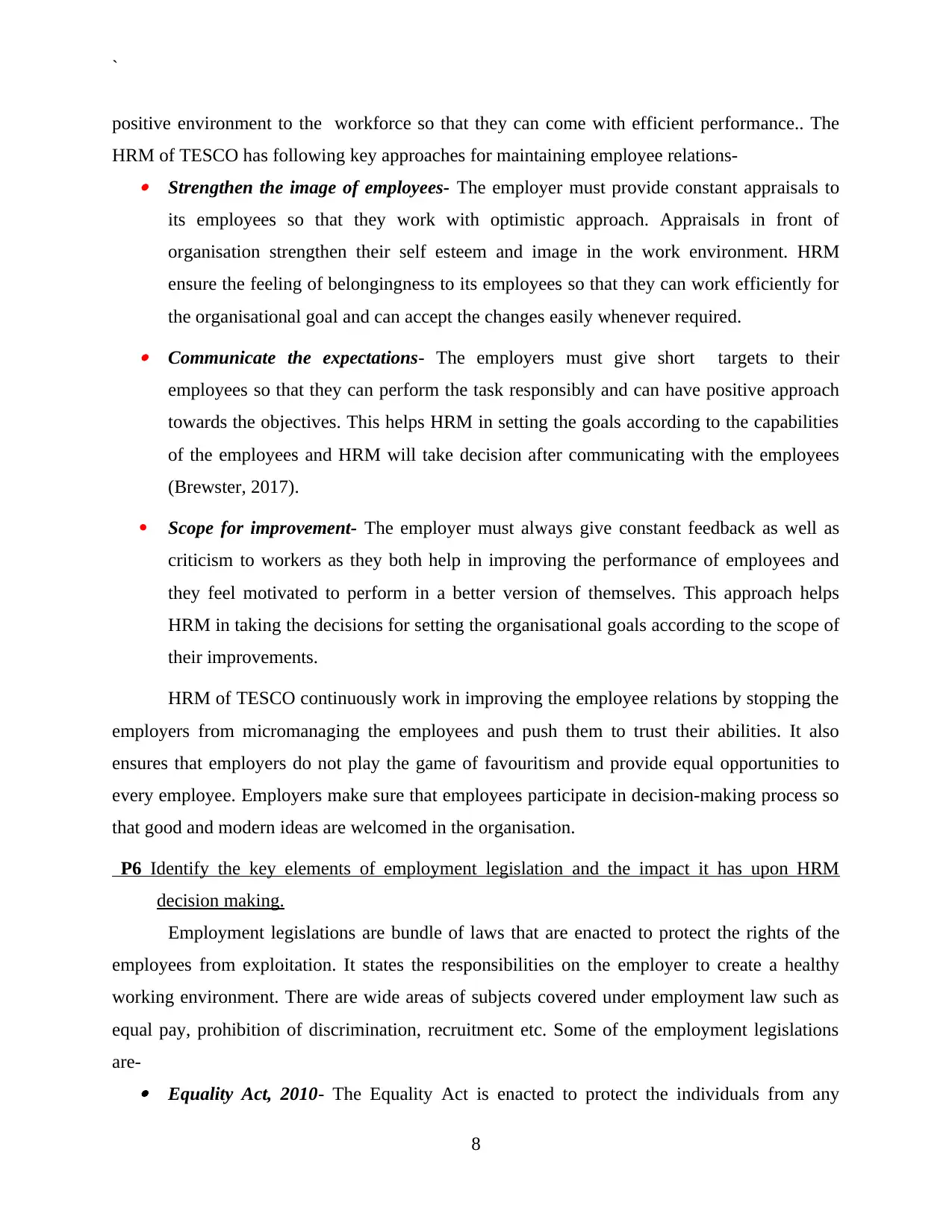
`
positive environment to the workforce so that they can come with efficient performance.. The
HRM of TESCO has following key approaches for maintaining employee relations- Strengthen the image of employees- The employer must provide constant appraisals to
its employees so that they work with optimistic approach. Appraisals in front of
organisation strengthen their self esteem and image in the work environment. HRM
ensure the feeling of belongingness to its employees so that they can work efficiently for
the organisational goal and can accept the changes easily whenever required. Communicate the expectations- The employers must give short targets to their
employees so that they can perform the task responsibly and can have positive approach
towards the objectives. This helps HRM in setting the goals according to the capabilities
of the employees and HRM will take decision after communicating with the employees
(Brewster, 2017).
Scope for improvement- The employer must always give constant feedback as well as
criticism to workers as they both help in improving the performance of employees and
they feel motivated to perform in a better version of themselves. This approach helps
HRM in taking the decisions for setting the organisational goals according to the scope of
their improvements.
HRM of TESCO continuously work in improving the employee relations by stopping the
employers from micromanaging the employees and push them to trust their abilities. It also
ensures that employers do not play the game of favouritism and provide equal opportunities to
every employee. Employers make sure that employees participate in decision-making process so
that good and modern ideas are welcomed in the organisation.
P6 Identify the key elements of employment legislation and the impact it has upon HRM
decision making.
Employment legislations are bundle of laws that are enacted to protect the rights of the
employees from exploitation. It states the responsibilities on the employer to create a healthy
working environment. There are wide areas of subjects covered under employment law such as
equal pay, prohibition of discrimination, recruitment etc. Some of the employment legislations
are- Equality Act, 2010- The Equality Act is enacted to protect the individuals from any
8
positive environment to the workforce so that they can come with efficient performance.. The
HRM of TESCO has following key approaches for maintaining employee relations- Strengthen the image of employees- The employer must provide constant appraisals to
its employees so that they work with optimistic approach. Appraisals in front of
organisation strengthen their self esteem and image in the work environment. HRM
ensure the feeling of belongingness to its employees so that they can work efficiently for
the organisational goal and can accept the changes easily whenever required. Communicate the expectations- The employers must give short targets to their
employees so that they can perform the task responsibly and can have positive approach
towards the objectives. This helps HRM in setting the goals according to the capabilities
of the employees and HRM will take decision after communicating with the employees
(Brewster, 2017).
Scope for improvement- The employer must always give constant feedback as well as
criticism to workers as they both help in improving the performance of employees and
they feel motivated to perform in a better version of themselves. This approach helps
HRM in taking the decisions for setting the organisational goals according to the scope of
their improvements.
HRM of TESCO continuously work in improving the employee relations by stopping the
employers from micromanaging the employees and push them to trust their abilities. It also
ensures that employers do not play the game of favouritism and provide equal opportunities to
every employee. Employers make sure that employees participate in decision-making process so
that good and modern ideas are welcomed in the organisation.
P6 Identify the key elements of employment legislation and the impact it has upon HRM
decision making.
Employment legislations are bundle of laws that are enacted to protect the rights of the
employees from exploitation. It states the responsibilities on the employer to create a healthy
working environment. There are wide areas of subjects covered under employment law such as
equal pay, prohibition of discrimination, recruitment etc. Some of the employment legislations
are- Equality Act, 2010- The Equality Act is enacted to protect the individuals from any
8
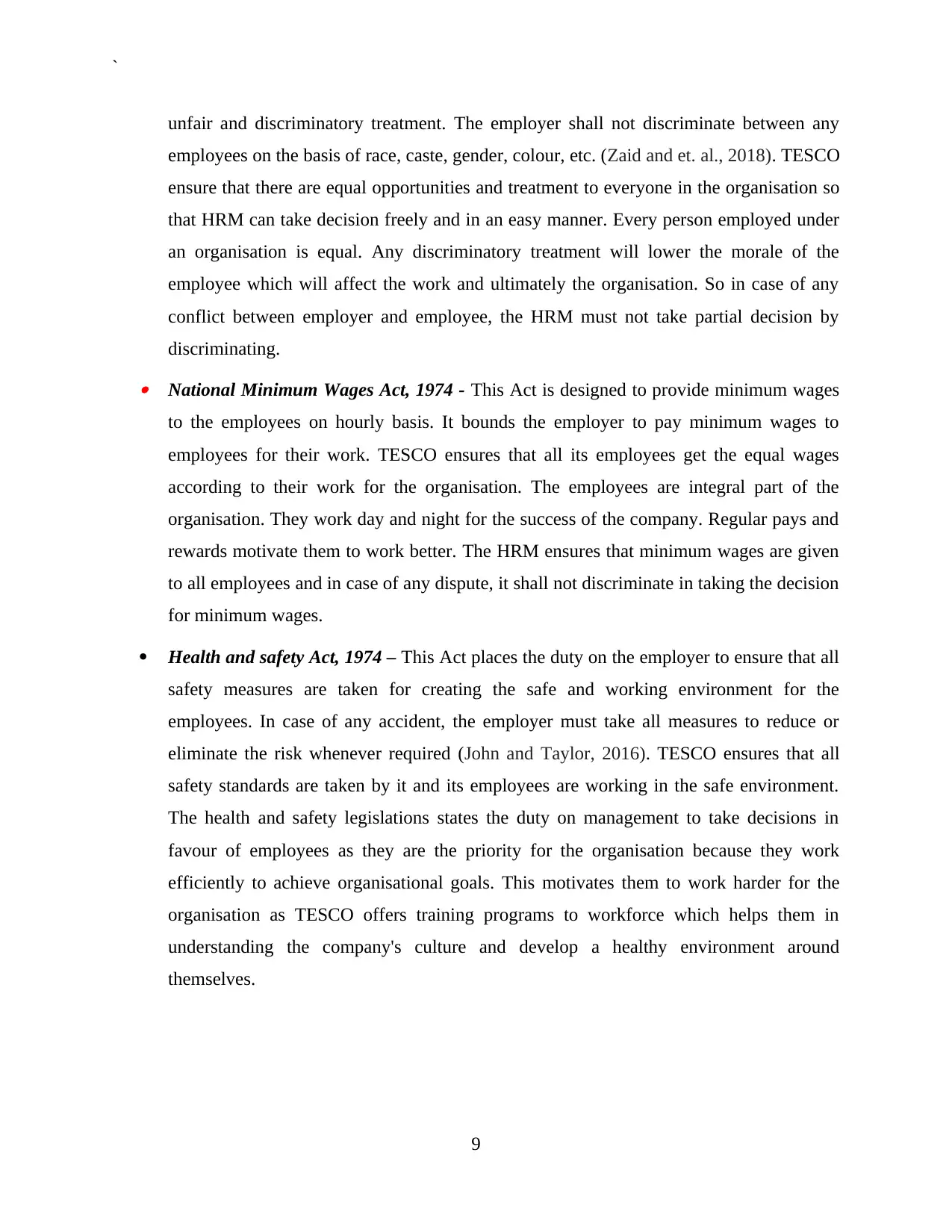
`
unfair and discriminatory treatment. The employer shall not discriminate between any
employees on the basis of race, caste, gender, colour, etc. (Zaid and et. al., 2018). TESCO
ensure that there are equal opportunities and treatment to everyone in the organisation so
that HRM can take decision freely and in an easy manner. Every person employed under
an organisation is equal. Any discriminatory treatment will lower the morale of the
employee which will affect the work and ultimately the organisation. So in case of any
conflict between employer and employee, the HRM must not take partial decision by
discriminating. National Minimum Wages Act, 1974 - This Act is designed to provide minimum wages
to the employees on hourly basis. It bounds the employer to pay minimum wages to
employees for their work. TESCO ensures that all its employees get the equal wages
according to their work for the organisation. The employees are integral part of the
organisation. They work day and night for the success of the company. Regular pays and
rewards motivate them to work better. The HRM ensures that minimum wages are given
to all employees and in case of any dispute, it shall not discriminate in taking the decision
for minimum wages.
Health and safety Act, 1974 – This Act places the duty on the employer to ensure that all
safety measures are taken for creating the safe and working environment for the
employees. In case of any accident, the employer must take all measures to reduce or
eliminate the risk whenever required (John and Taylor, 2016). TESCO ensures that all
safety standards are taken by it and its employees are working in the safe environment.
The health and safety legislations states the duty on management to take decisions in
favour of employees as they are the priority for the organisation because they work
efficiently to achieve organisational goals. This motivates them to work harder for the
organisation as TESCO offers training programs to workforce which helps them in
understanding the company's culture and develop a healthy environment around
themselves.
9
unfair and discriminatory treatment. The employer shall not discriminate between any
employees on the basis of race, caste, gender, colour, etc. (Zaid and et. al., 2018). TESCO
ensure that there are equal opportunities and treatment to everyone in the organisation so
that HRM can take decision freely and in an easy manner. Every person employed under
an organisation is equal. Any discriminatory treatment will lower the morale of the
employee which will affect the work and ultimately the organisation. So in case of any
conflict between employer and employee, the HRM must not take partial decision by
discriminating. National Minimum Wages Act, 1974 - This Act is designed to provide minimum wages
to the employees on hourly basis. It bounds the employer to pay minimum wages to
employees for their work. TESCO ensures that all its employees get the equal wages
according to their work for the organisation. The employees are integral part of the
organisation. They work day and night for the success of the company. Regular pays and
rewards motivate them to work better. The HRM ensures that minimum wages are given
to all employees and in case of any dispute, it shall not discriminate in taking the decision
for minimum wages.
Health and safety Act, 1974 – This Act places the duty on the employer to ensure that all
safety measures are taken for creating the safe and working environment for the
employees. In case of any accident, the employer must take all measures to reduce or
eliminate the risk whenever required (John and Taylor, 2016). TESCO ensures that all
safety standards are taken by it and its employees are working in the safe environment.
The health and safety legislations states the duty on management to take decisions in
favour of employees as they are the priority for the organisation because they work
efficiently to achieve organisational goals. This motivates them to work harder for the
organisation as TESCO offers training programs to workforce which helps them in
understanding the company's culture and develop a healthy environment around
themselves.
9
⊘ This is a preview!⊘
Do you want full access?
Subscribe today to unlock all pages.

Trusted by 1+ million students worldwide
1 out of 16
Related Documents
Your All-in-One AI-Powered Toolkit for Academic Success.
+13062052269
info@desklib.com
Available 24*7 on WhatsApp / Email
![[object Object]](/_next/static/media/star-bottom.7253800d.svg)
Unlock your academic potential
Copyright © 2020–2025 A2Z Services. All Rights Reserved. Developed and managed by ZUCOL.





